This was published 6 years ago
The ryokan experience in Kinosaki Onsen, Japan: Japanese onsen town where it's obvious you're a foreigner
By Daniel Scott
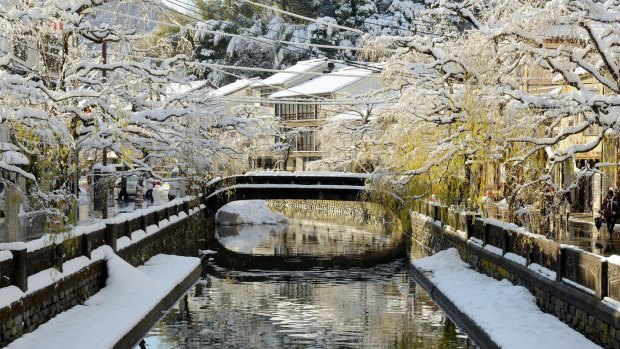
A bridge in Kinosaki Onsen covered by snow.
It's beginning to snow as my train nears the small town of Kinosaki Onsen, lending an ethereal veneer to the hills north-west of Kyoto. Arriving at the station, I can see the steamy breath of several people huddled outside, among them Noro Randria, my "local" guide. Randria is a young French Madagascan, whose obsession with Japanese culture led her to come to the hot spring resort of Kinosaki to live and work.
Also clopping along nearby are a Japanese couple wearing yukata – a traditional wraparound robe secured around the waist with an "obi" band – as well as socks, wooden sandals and warm overcoats.
"The whole of Kinosaki is like one big ryokan or Japanese inn," explains Randria, "with the station like the front door, the roads its hallways and each inn a different room.
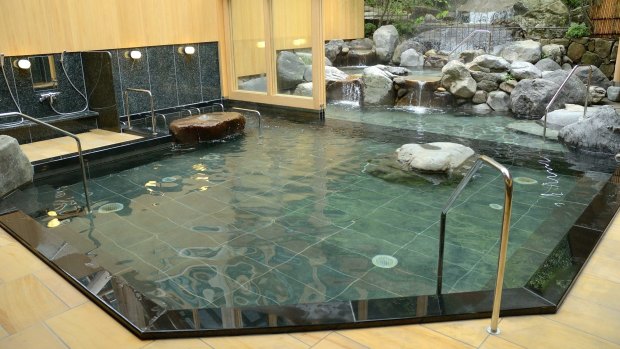
Bath house in Kinosaki Onsen.
"So, rather than always have to get changed to walk between their accommodation and Kinosaki's seven bathhouses," she adds, "people slip on yukata, which each ryokan lends guests for free."
According to legend, the discovery of Kinosaki's hot springs dates back to the Asuka period in the sixth and seventh century when an oriental white stork was witnessed bathing its wounds in the waters.
Officially, though, it was the Buddhist priest Dochi Shonin who first brought attention to the springs during the eighth century Nara period.
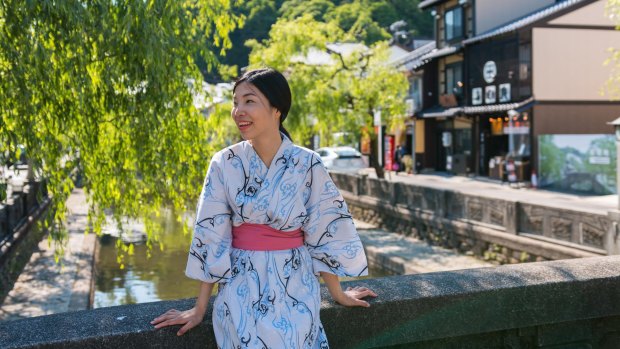
A woman in Yukata, Japanese traditional clothes.Credit: Shutterstock
A temple dedicated to Shonin, the Onsenji stands at the far end of town on the slopes of Mount Daishiyama, and it's here that most visitors come to give thanks before embarking on their ablutions.
Reached via a cable car, the top of Mount Daisihi normally heralds views over the whole town and nearby coastline, but today the surrounds are dank and mushy.
Yet, back on street-level, even in these wintry conditions, Kinosaki, rebuilt in traditional style following an earthquake in 1925, seems compact and pretty.
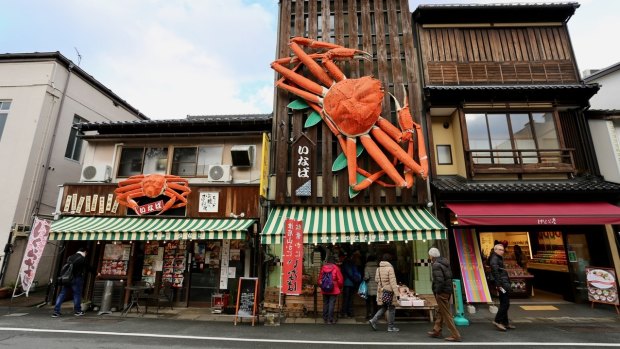
Matsuba crab season Kinosaki Onsen.Credit: Daniel Scott
Wiry cherry blossom trees line the banks of the central Otanigawa river and three-storey wooden ryokan are interspersed between the sotoyu (public bathhouses).
It's now also the November-March Matsuba crab season, a specialty of this region's cuisine along with Tajima beef. There are extravagant representations of crustaceans above shops and restaurants all around town.
Lovely though it is outside, I'm keen to check in to the cosy Mikuniya ryokan, half-way down the main street, and to experience my first Kinosaki bathhouse.
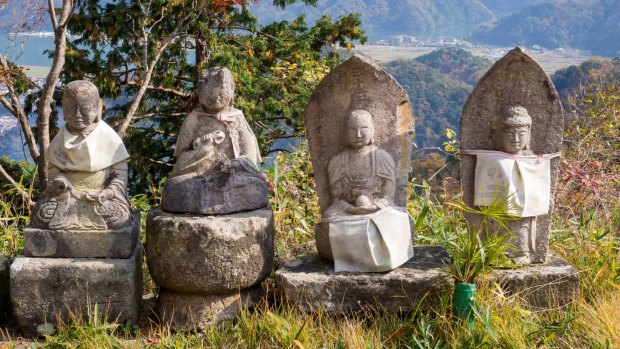
Kinosaki Onsen is a small town in Toyooka. This is an onsen (Japanese hotspring) town for a relaxing vacation.Credit: Shutterstock
After adorning myself in a yukata, incongruously worn over my thermal underwear and with sneakers as I find the wooden sandals too uncomfortable, I wander self-consciously across town and am drawn first into the grand entrance way of the Goshonoyu bathhouse, adjacent to a shrine.
As I store my shoes in a locker in the foyer, a young Japanese family arrives, Dad and Mum with 10-year-old son and eight-year-old daughter, separating to enter the male and female sections.
Inside the male changing room, I get unchanged and notice how the father leads his very serious-looking son through the bathing ritual, passing on the centuries-old etiquette.
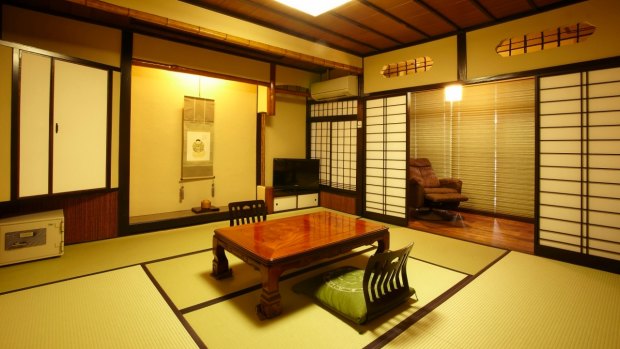
Japanese style room.
For anybody used to playing competitive team sports same-sex nudity isn't that confronting and it's all so matter-of-fact inside the bathhouse that it shouldn't be an issue.
However, brandishing nothing bigger than a hand towel for modesty, I'm grateful to slip into the first bath, one of several open cubicles with side rails to hold onto and upwelling bubbles to soothe aches and pains.
Being British of origin I love a bath, indeed it was the only way to get warm in the bad old days of crappy uni accommodation in relentlessly rainy, cold Manchester, and so I take to the onsen experience like a lucky duck, sinking up to my neck in the steaming water.
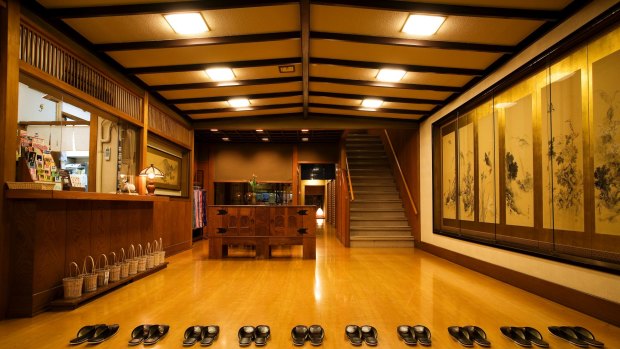
Kinosaki Onsen.
I also see a long soak as a creative space, doing much of my reading in the tub and often jotting ideas into a notebook and it seems I am not alone.
Over the centuries, Kinosaki has attracted many writers and artists, including 20th-century Japanese author Shiga Naoya, who wrote stories about the town.
At night, Kinosaki has the feel of a fairy tale, with paper lanterns along the riverside, lights reflected in the water and visitors wandering about in their yukata.
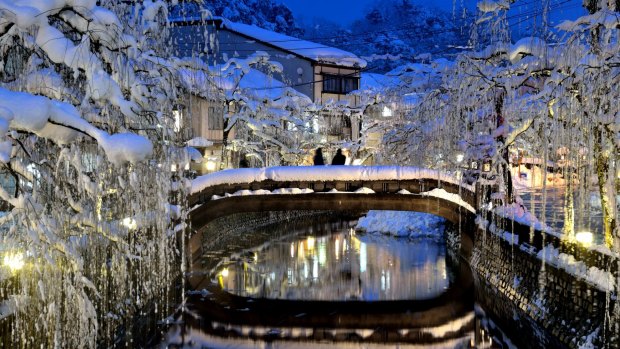
At night, Kinosaki has the feel of a fairy tale.
Nonetheless, once back in my tatami-matted room at the ryokan, my bones warmed through by bathing, I'm more than happy to have a traditional kaiseki dinner served to me in my room (crab and beef included) and avail myself of the free Wi-Fi to Facetime my wide-eyed daughters.
The next morning I start the day at a second bathhouse, Jizouyu, just down the street, one of four that open at 7am. No sotoyu is further than 400 metres from the next and if you're staying at any Kinosaki ryokan, you're entitled to free entry to all seven.
Jizouyu is already busy in the early morning and while my body rhythms are better suited to a long afternoon soak, my visit prepares me well for a day visiting nearby Izushi, a castle town that prospered during the Edo period, between 1603 and 1868.
After taking in the ruins of the samurai-built castle in the foothills above Izushi, and getting a behind-the-scenes tour of the town's restored Eirakukan kabuki theatre, our next stop is one of its 50 noodle shops.
Izushi's Sara Soba noodles are distinct from the heartier type served elsewhere, are served on small plates made from fine white porcelain and require a delicate hand in the making.
I find this out during a soba noodle making experience under the tutelage of master practitioner, Amemori. While Amemori and my guide Randria make light work of the dough created from 300 grams of buckwheat flour and 150ml of water, my efforts are laughably lumpy.
I'm not much better at Zazen meditation, which I try next, at Sukyoji Temple.
Led by Buddhist monk, Udo Kohara, I try hard to adopt the correct seated and cross-legged posture for this meditative technique and even harder to concentrate on the sounds of nature outside. But I get too fixated on my aching knees and racing thoughts to succeed.
Yet the half-hour meditation does leave me in a contemplative mood and I'm drawn to the monk's gentle spirit and selfless dedication.
Over a tea ceremony I ask Kohara his definition of happiness, that most elusive of 21st-century concerns.
He pauses for a while, then answers:
"In order to become happy," he says, "you have to experience true despair."
He goes on to explain that for him, the long periods of meditation he undertook as a monk were sometimes extremely painful but that he came to see that the body was "merely the vessel for the human spirit".
He therefore understood that he had to accept the pain to work toward being in the best condition to accept death.
Back in Kinosaki, I transfer next door to a more modern ryokan, Enn, and head out to dinner with my guide, remembering the monk's words as I struggle to get comfortable kneeling Japanese-style at the table.
Later we spend an hour in a tiny karaoke bar, where Katsuko Habuchi, the sweet old lady serving us, sings us a Japanese love song and gifts me a hand-fashioned origami stork.
My winter visit to Kinosaki has been timely, allowing me, like that mythical stork of way-back-when, to begin healing the emotional wounds inflicted by multiple losses and separation, and to recognise that sometimes, happiness can be as simple as a warm bath.
TRIP NOTES
MORE
FLY
Japan Airlines flies from Melbourne and Sydney to Osaka's Kansai airport. Phone 1300 525 287, see au.jal.com
RAIL
Kinosaki Onsen is accessible by train from Kyoto (two hours 30 minutes) and Osaka (two hours 40 minutes) and JR rail passes can be used to visit the town.
STAY
Ryokan Mikuniya, Kinosaki.
Rates start from 8,100 JPY ($92) per person sharing a room with no meals. Rates for a traditional Japanese banquet style dinner of Tajima beef and breakfast served in the room costs from 17,280 JPY pp sharing a Japanese style room, includes yukata rental and a pass for seven public onsens. Visitkinosaki.com
Ryokan Koyado Enn, Kinosaki
Rates from 7,560 JPY per person per night sharing a Japanese room, no meals. Koyado.net
Daniel Scott was a guest of Toyooka City Council.
Sign up for the Traveller Deals newsletter
Get exclusive travel deals delivered straight to your inbox. Sign up now.